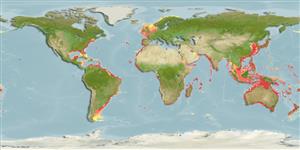Common names from other countries
Environment: milieu / climate zone / depth range / distribution range
Ecologie
; diepteverspreiding 3 - 120 m (Ref. 81749). Tropical
Circumglobal.
Length at first maturity / Size / Gewicht / Leeftijd
Maturity: Lm ? range ? - ? cm
Epibiotic (Ref. 111011). Occurs in subtidal and low tide areas, and it usually covers bare rocks. Found on a dead branch of A. wollastoni (Ref. 2767). Part of fouling communities attached to raft frames in mariculture zones (Ref. 127121).
Life cycle and mating behavior
Geslachtsrijpheid | Voortplanting | Kuitschieten | Eieren | Fecundity | Larven
Members of the superorder Thoracica are mostly hermaphroditic. Broadcast spawners, fertilization occurs in the mantle cavity. Life cycle: Eggs hatch into planktonic nauplii and leave the mantle cavity. Afterwards, they undergo six naupliar instars succeded by nonfeeding cypris larva (settling stage) which later metamorphose into adults.
Young, P.S. 1998. (Ref. 3549)
Status op de Rode Lijst van het IUCN (Ref. 130435)
Status bij CITES (Ref. 108899)
Not Evaluated
Not Evaluated
Gebruik door de mens
| FishSource |
Tools
Meer informatie
Leeftijd/Grootte
Groei
Lengte-gewicht parameters
Lengte-lengte parameters
Morfologie
Larven
Abundantie
Internet-bronnen
Estimates based on models
Preferred temperature
(Ref.
115969): 17 - 28.2, mean 26.1 (based on 1668 cells).
Prijsklasse
Unknown.
